[go-to basic recipe]
EGGS
Is it breakfast or is it dinner? We’ll let you choose. Pick an egg-prep method—hard-boiled, fried, scrambled, poached, or omelet—for any occasion.
Hard-Boiled Eggs
start to finish 25 minutes
- 6 large eggs
1. Place eggs in a single layer in a 3-qt. saucepan (do not stack eggs). Add enough cold water to cover the eggs by 1 inch. Bring to a rapid boil over high heat (water will have large rapidly breaking bubbles). Remove from heat, cover, and let stand 15 minutes (18 minutes for extra- large eggs); drain. Place in ice water until cool enough to handle; drain.
2. To peel eggs, gently tap each egg on the countertop. Roll egg on countertop under the palm of your hand. Peel off eggshell, starting at the large end.
Makes 6 eggs.
*Note For soft-boiled eggs, bring water to boiling. Using a slotted spoon, lower eggs into water. Reduce heat to maintain a gentle boil. Boil 6 minutes for soft-boiled or 8 minutes for jammy (not set) yolk.
each egg 78 cal., 5 g fat (2 g sat. fat), 212 mg chol., 62 mg sodium, 1 g carb., 0 g fiber, 0 g sugars, 6 g pro.

easy peeling
There’s a secret to peeling eggs. Whenever possible, use eggs that are 7 to 10 days old. As eggs age, the air pocket in the shell grows, making it easier to dislodge the shell after boiling.
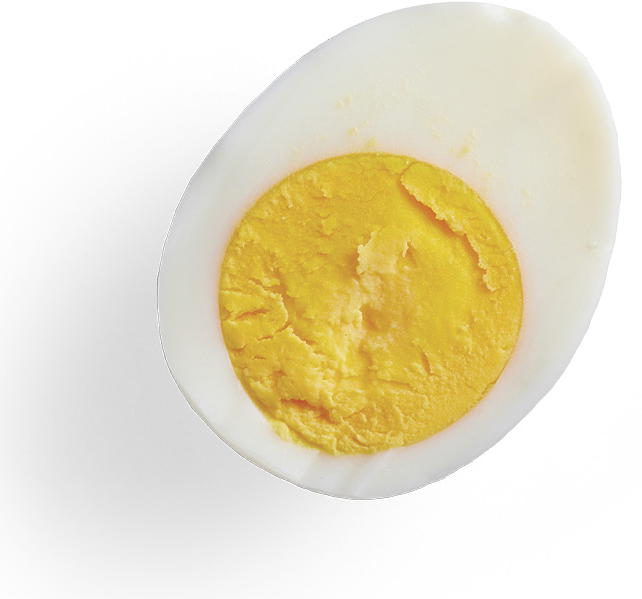
hard yolk
15
minutes

jammy yolk
8
minutes

soft yolk
6
minutes
SOFT AND JAMMY YOLKS
Soft and jammy cooked eggs are popping up in more than just breakfast dishes, including ramen noodle bowls, salads, pasta, asparagus, and grain bowls. Follow the timings above to get the yolk consistency you desire. In addition to a halved soft-boiled egg, this grain bowl contains cooked tricolor quinoa, a roasted sweet potato half, steamed kale, roasted chickpeas, chopped avocado, snipped fresh chives, and salt and black pepper.
Fried Eggs
start to finish 10 minutes
- 2 tsp. butter or nonstick cooking spray
- 4 eggs
- Salt and black pepper
1. In a 10-inch skillet melt butter over medium heat. (Or coat an unheated skillet with cooking spray.) Break eggs into skillet. Sprinkle with salt and pepper. Reduce heat to medium-low. For sunny-side-up fried eggs, cook eggs 3 to 4 minutes or until whites are almost completely set and yolks start to thicken.
2. For over-easy or over-hard fried eggs, when the whites are completely set and the yolks start to thicken, turn the eggs and cook 30 seconds more (over-easy) or 1 minute more (over-hard).
Makes 4 eggs.
Steam-Basted Fried Eggs Prepare as directed, except when egg edges turn white, add 1 to 2 tsp. water. Cover skillet and cook eggs 3 to 4 minutes or until yolks begin to thicken but are not hard.
each egg 88 cal., 7 g fat (3 g sat. fat), 217 mg chol., 84 mg sodium, 0 g carb., 0 g fiber, 0 g sugars, 6 g pro.
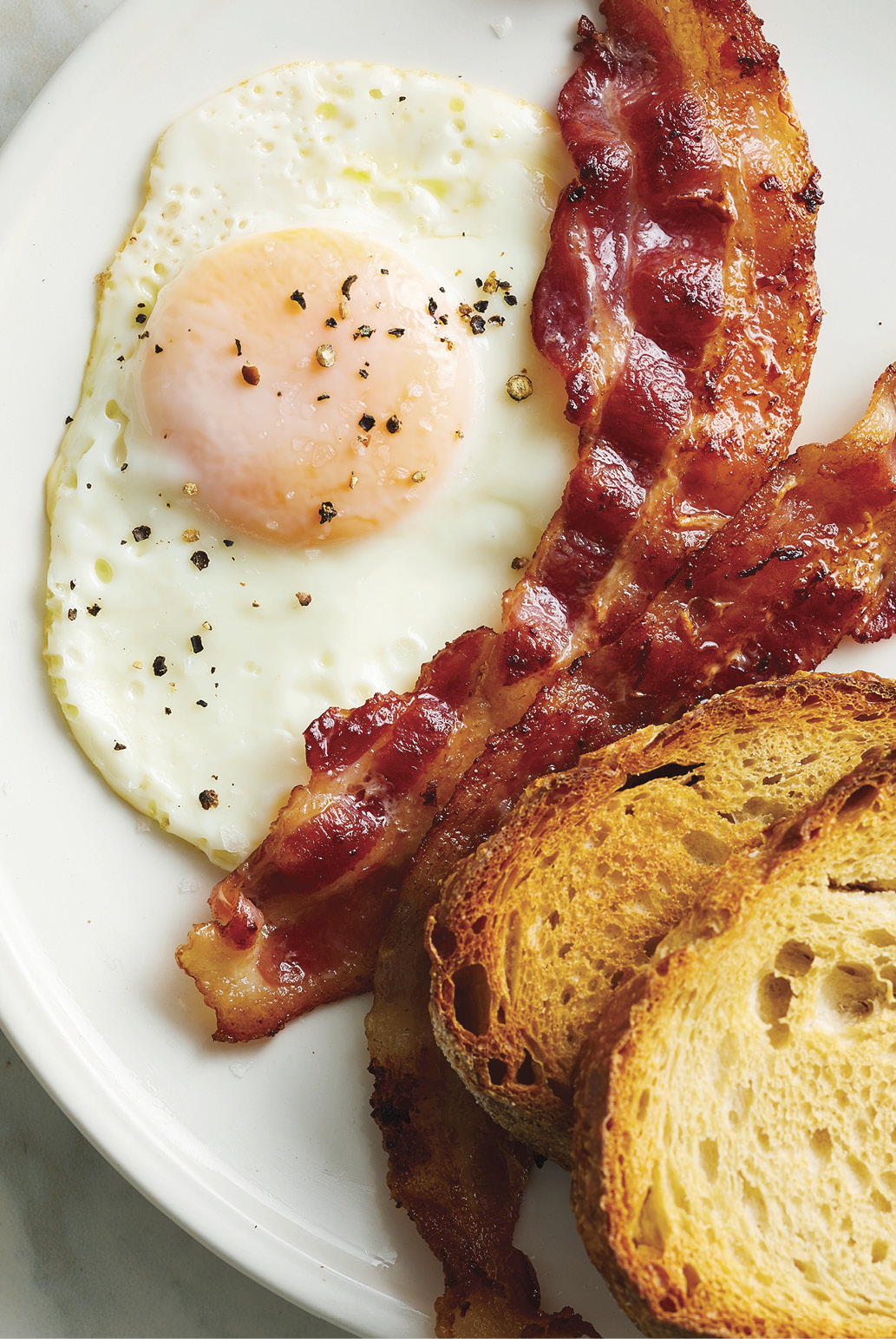
Firm-set yolk
If you like your fried eggs without runny yolks (but like the sunny-side-up look), break the yolk after adding the egg to the skillet. It will cook in the same time it takes to cook the white.

Heat the butter in the pan, swirling to coat bottom. Get the pan fairly hot before adding the eggs so they set quickly and don’t run together. Cook eggs in batches to avoid overcrowding the pan.

For over-easy or over-hard eggs, use a pancake turner to carefully flip the eggs when the whites are nearly set. (Be gentle so the yolks don’t break.)

To set the tops of the eggs without flipping them, try steam-basting. Instead of turning the eggs, add 1 to 2 Tbsp. water to skillet; cover. Cook until yolks are set but still a little runny.
Scrambled Eggs
See recipe for more scrambled egg info and ideas.
start to finish 10 minutes
- 6 eggs
- ⅓ cup milk or half-and-half
- ¼ tsp. salt
- 1 Tbsp. butter
1. In a bowl whisk together eggs, milk, salt, and a dash black pepper. In a 10-inch skillet melt butter over medium heat; pour in egg mixture. Cook, without stirring, until mixture begins to set on bottom and around edges.
2. Using a spatula or large spoon, lift and turn partially cooked egg mixture so that uncooked portion flows underneath (below). Continue cooking 2 to 3 minutes or until egg mixture is cooked through but is still glossy and moist. Immediately remove from heat.
Makes 3 servings (¾ cup each).
each serving 191 cal., 14 g fat (6 g sat. fat), 384 mg chol., 379 mg sodium, 2 g carb., 0 g fiber, 2 g sugars, 13 g pro.

Add eggs to hot skillet; let sit 20 to 30 seconds or until ribbons of cooked eggs begin to form before you put your spatula to work. Lift and fold the eggs toward the center of the pan, allowing uncooked eggs to flow under the spatula. Keep lifting and folding eggs until they are just set and still appear slightly wet.
Poached Eggs
start to finish 10 minutes
- 4 cups water
- 1 Tbsp. vinegar
- 4 eggs
- Salt and black pepper
1. Add water to a 10-inch skillet; add vinegar. Bring to boiling; reduce heat to simmering (bubbles should begin to break the surface of the water).
2. Break an egg into a cup and slip egg into simmering water. Repeat with remaining eggs, allowing each egg an equal amount of space in the water.
3. Simmer eggs, uncovered, 3 to 5 minutes or until whites are completely set and yolks begin to thicken but are not hard. Remove eggs. Season to taste with salt and pepper.
Makes 4 eggs.
To Make Ahead Poach eggs as directed. Place cooked eggs in a bowl of cold water. Cover; chill up to 2 hours. To reheat eggs, in a saucepan bring water to simmering. Use a slotted spoon to slip eggs into water; heat 2 minutes. Remove with slotted spoon.
each egg 78 cal., 5 g fat (2 g sat. fat), 212 mg chol., 62 mg sodium, 1 g carb., 0 g fiber, 0 g sugars, 6 g pro.
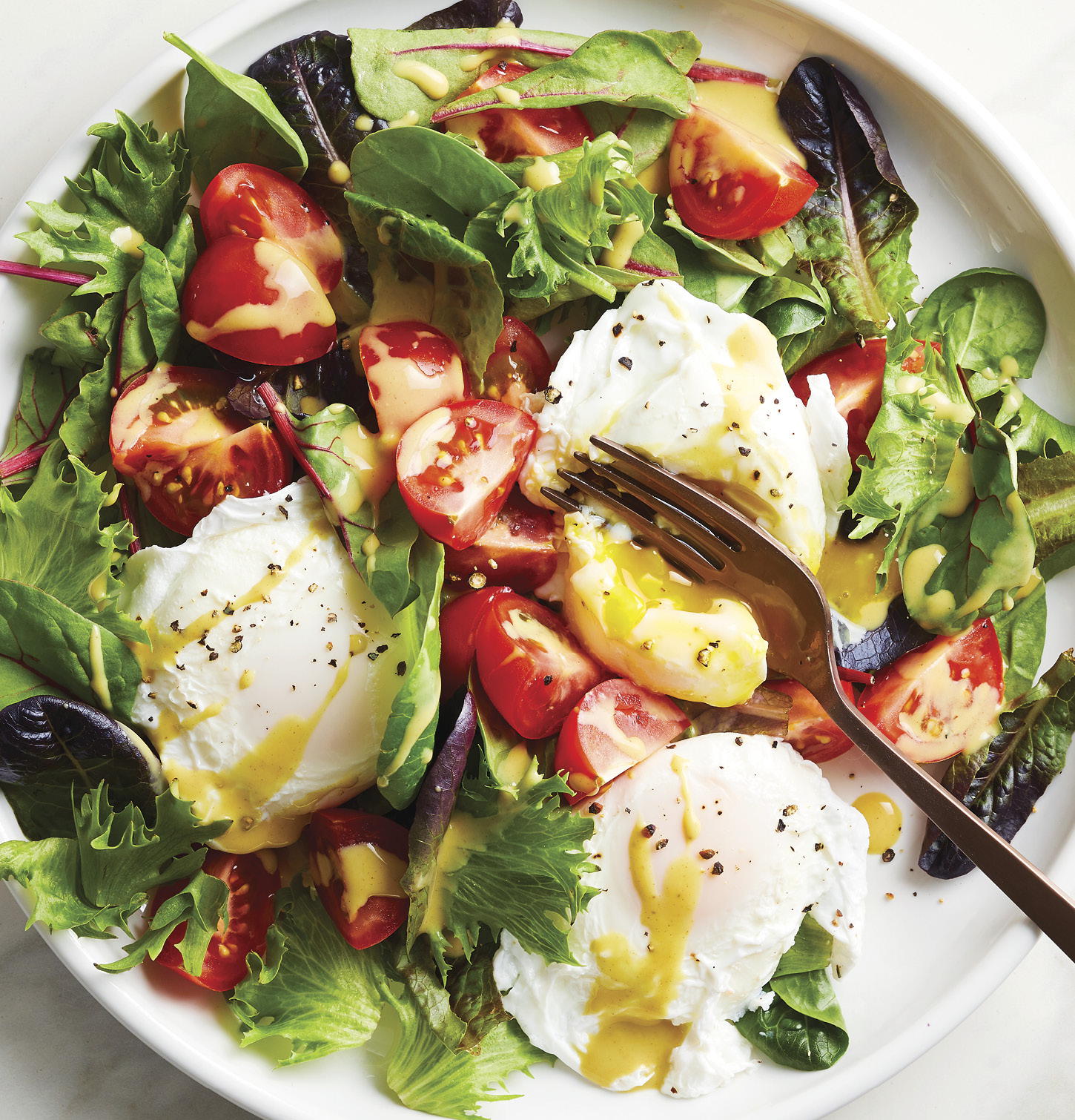
vinegar splash
We add a splash of vinegar to the simmering poaching water to help the protein in the egg whites coagulate quickly for a more uniform shape.

Hold the lip of the cup close to the simmering water to slip the whole egg in at once—this prevents the white from spreading and getting stringy.

When the eggs are cooked, use a slotted spoon to remove them from the skillet, letting the water drain away from the eggs.
poaching pan
Special pans aren’t required for poaching, but they do create a perfectly shaped poached egg. If you use one, follow the manufacturer’s directions for cooking (4 to 6 minutes). Run a knife around edges to loosen eggs.

Easy Omelet
start to finish 10 minutes
- 2 eggs
- 2 Tbsp. water
- ⅛ tsp. salt
- Dash black pepper
- 1 Tbsp. butter
- ⅔ to 1 cup desired fillings
- Desired toppers (optional)
1. In a bowl combine eggs, water, salt, and pepper. Beat with a fork until combined but not frothy.
2. Heat an 8-inch nonstick skillet with flared sides over medium-high heat. Melt butter in skillet. Add egg mixture to skillet; reduce heat to medium. With a heatproof spatula, begin stirring gently but continuously until egg mixture turns into small pieces of cooked egg surrounded by liquid egg. Stop stirring. Cook 30 to 60 seconds more or until egg is set and shiny.
3. Arrange filling on half of omelet. Lift edge over filling to fold omelet in half. (If making more than one omelet, keep warm while preparing additional omelets.) If desired, add toppers.
Makes 1 omelet.
Egg White Omelet Prepare as directed, except substitute 2 egg whites for one of the whole eggs.
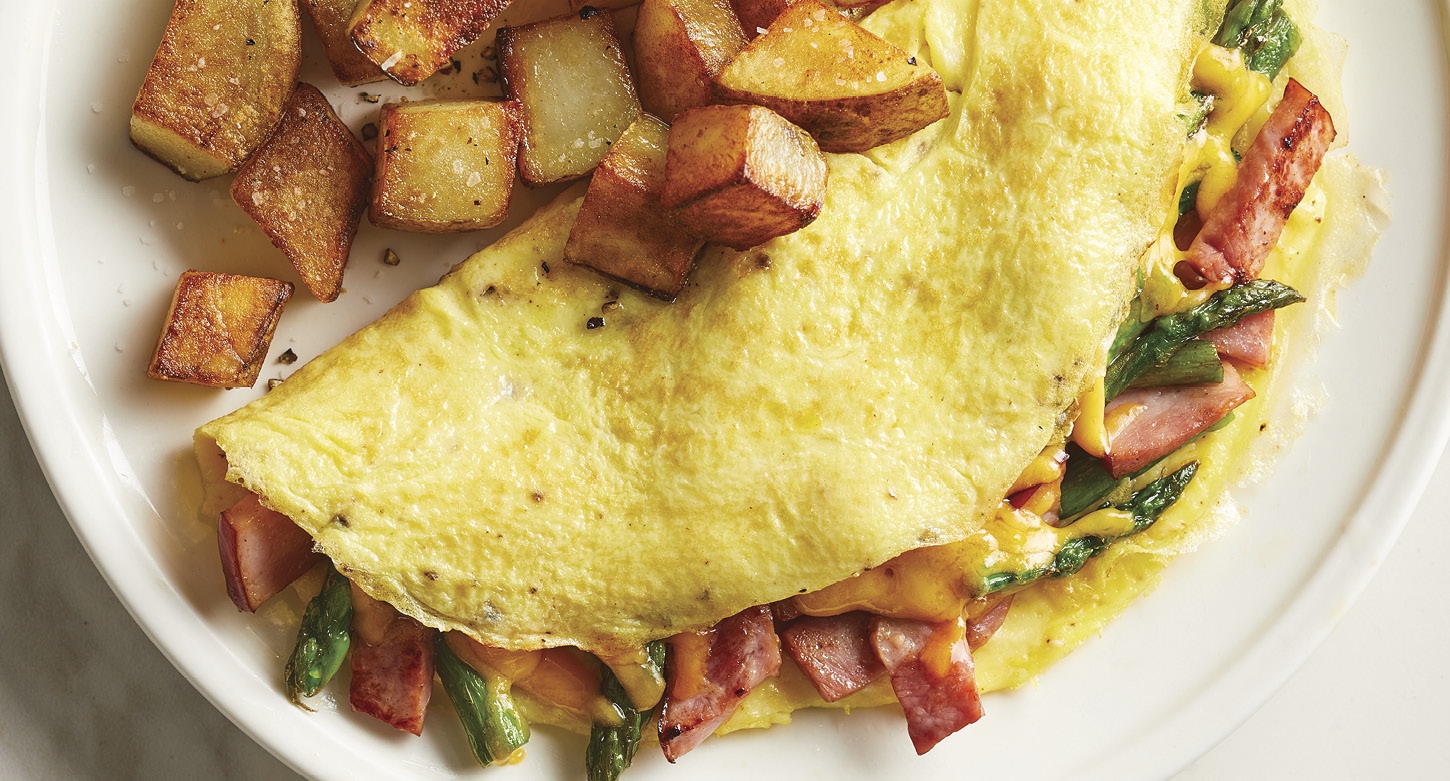
fillings

CHEESE mozzarella, Parmesan, cheddar, feta

MEATS cooked bacon, smoked salmon, cooked kielbasa, cooked ham


VEGETABLES grape tomatoes, avocado, spinach, sautéed mushrooms, cooked broccoli, caramelized onions, sautéed peppers, steamed asparagus


toppers
Olive tapenade, sour cream or Greek yogurt, fresh salsa, or Tzatziki Sauce; fresh herbs such as basil, oregano, Italian parsley, or dill
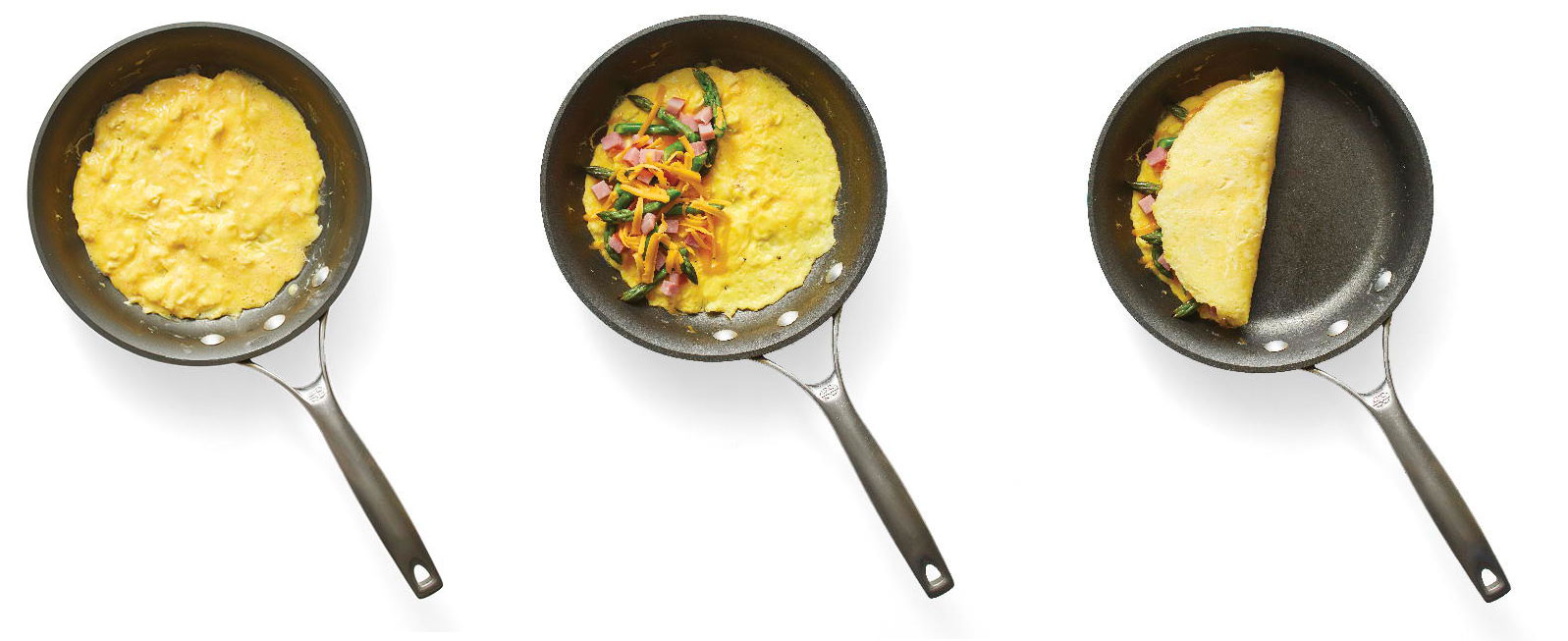
Immediately reduce the heat to medium after adding the egg mixture to the skillet to avoid overbrowning the bottom of the omelet.
Put the fillings on one half of the egg mixture.
Use a heatproof spatula (instead of a pancake turner) to fold the other half of the omelet over the top of the filling.